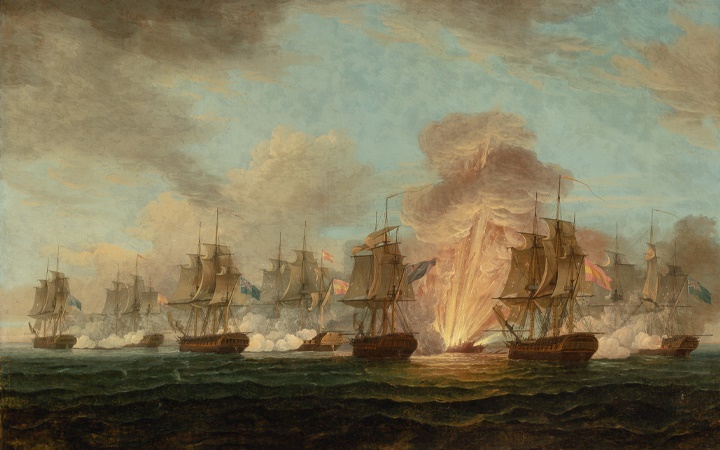The End of the Spanish Silver Fleet
05/18/2022 Old Master Paintings

NEW YORK, NY -- From the 1560s to 1790, the Spanish Empire maintained a system of sea routes for convoys of ships to carry goods from Spain to her colonies in the New World and to bring back valuable materials from the Americas and Asia to Spain. These convoys were known loosely as the Flota de Indias (the Indies Fleet) or, to English speakers, “the Spanish Silver Fleet,” since their most important cargoes were the silver and gold they brought from Mexico, Peru, and Bolivia. The ships plying these routes also carried a variety of other precious goods, including spices, silk, pearls and ivory from Asia; and jewels, lumber, sugar and exotic foods such as quinoa from the Americas.
The treasure ships were organized into several fleets, one traveling across the Pacific from Manila to Acapulco -- from which Asian goods could be carried by pack mule to Vera Cruz to be loaded onto ships on their way back to Spain -- and others that visited various ports in South America, Mexico and the Caribbean.
The Spanish Silver Fleet was the first organized trans-Atlantic and trans-Pacific maritime traffic system, and it was so successful that it lasted for more than two centuries. The enormous wealth it brought to Spain made her the richest and most powerful state in Europe during that period.
Beginning in the 1560s, all commercial sea trade from the Americas was required by law to enter Spain through the port of Seville; later Cádiz was added as a second port. Normally two distinct fleets, each numbering between 30 and 90 ships, sailed from Seville or Cádiz every year. The earlier of these departed in the spring for Vera Cruz, in Mexico, with ships detaching from the convoy along the way to stop at various ports in the Caribbean and Honduras. The second fleet left Spain in August for Cartagena (in modern-day Colombia) and Porto Bello on the Atlantic coast of Panama. After wintering in America, both fleets met at Havana in the spring and came home, escorted by warships. This rich commerce was the envy of most other European countries, particularly France and Great Britain, who encouraged pirates and privateers to attack and plunder the Spanish ships.
The Silver Fleet system was brought to a sudden halt in October 1804, in the Battle of Cape Santa Maria, fought between the British Royal Navy and a small convoy of Spanish treasure ships. Having learned of a secret alliance between France and Spain against Great Britain, and convinced that war would be declared soon after the arrival of the convoy in Cádiz, the British government sent a naval squadron under the command of Commodore Graham Moore to intercept and detain the Spanish ships. On October 5, Moore, commanding the 44-gun frigate H.M.S. Indefatigable and accompanied by H.M.S. Lively, H.M.S. Medusa and H.M.S. Amphion, approached the Spanish flotilla off Cape Santa Maria, on the coast of Portugal.
A record of the ensuing battle was made by the English marine artist Nicholas Pocock (1740-1821), based on a series of interviews with British seamen who were present when it took place. His resulting work, The Battle of Cape Santa Maria, depicts the first exchange of fire, during which a single shot from the Amphion struck the magazine of the Spanish frigate Mercedes, exploding it and sinking the ship. Within a half-hour two of the remaining Spanish frigates, the Medusa and the Santa Clara, had surrendered, and a third, the Fama, was captured soon thereafter. These three surviving ships were escorted to Britain and their cargoes confiscated.
Spain declared war on the United Kingdom two months later, beginning a conflict that ended with Spain's sustaining a devastating defeat at the Battle of Trafalgar the following year in October 1805. The Battle of Cape Santa Maria thus effectively put an end to Spain's transport of silver and gold from the New World and brought to a close her status as a great power.
The wreck of the destroyed Mercedes was discovered in 2007 and partially salvaged. After a lengthy legal dispute, the ship's cargo was awarded to Spain in 2012.
Old Master & 19th Century Paintings & Drawings
Auction Tuesday, May 24, 2022 at 10am
Exhibition May 21 - 23
A highlight of the May 24 auction is Nicholas Pocock's masterful depiction of the Battle of Cape Santa Maria.